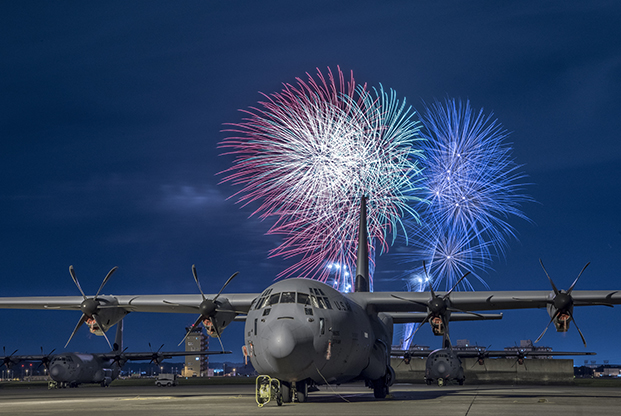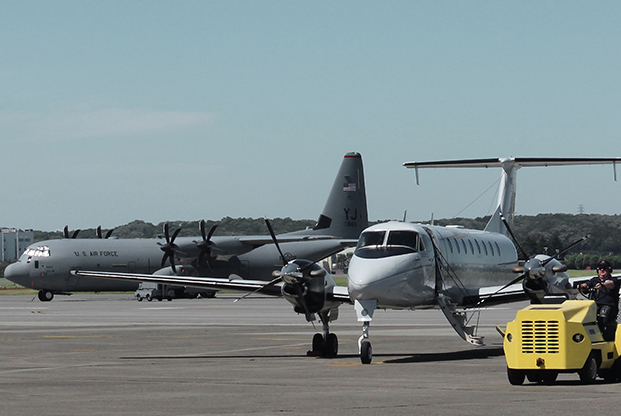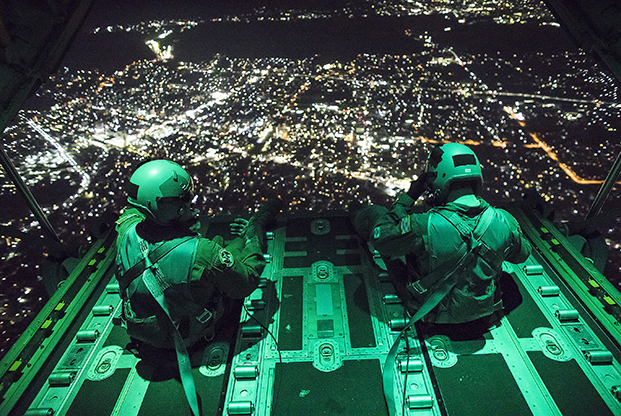
A C-130J on the flight line at Yokota AB, Japan, as fireworks light the sky during Celebrate America festivities on the base. Photo: SrA. Donald Hudson
Yokota Air Base has become a critical hub for US Air Force operations in Japan; the critical waypoint for VIPs conducting top-level regional business as well as aircraft, missions, and cargo that cement the US-Pacific relationship.
Located within metropolitan Tokyo and integrated with that city’s air traffic control system, since mid-2017 Yokota has played host to all levels of the Air Force chain of command, from the president on down, as well as Secretary of State Mike Pompeo, who transits there frequently. President Donald J. Trump stopped at Yokota on his first visit to Asia in 2017 and again this year before the Singapore meeting with North Korean leader Kim Jong Un.
“I don’t know of too many other bases who can say that,” observed Col. Kenneth E. Moss, then-commander of the 374th Airlift Wing at Yokota. “I don’t know of a base in history, over that short period of time, that has seen that lineup of visitors.”
The flow of VIPs in 2017-2018 also included Defense Secretary Jim Mattis, who came through on an E-4B Advanced Airborne Command Post.
The US attention to Japan “shows the importance of this area and the emphasis the highest level of our leadership is putting here,” Col. Jean Eisenhut, 5th Air Force chief of staff, told Air Force Magazine during a recent visit.
The new National Defense and National Security strategies in place since early this year focus on “great power competition” with China, the threat from North Korea, and Russia’s ongoing influence, coupled with the continuous need for humanitarian aid in the region. Yokota’s importance can only rise along with the US emphasis on the Pacific.
The National Security Strategy asserts that “US allies are critical to responding to mutual threats, such as North Korea, and preserving our mutual interests in the Indo-Pacific region. … We welcome and support the strong leadership role of our critical ally, Japan.”
Yokota is headquarters of 5th Air Force and US Forces, Japan. It’s relatively small for an overseas Air Force air base. Yokota has only a medium runway and small population, but it has been upping its game with more modern equipment, a quicker operating tempo, and regular drills to surge everything from fuel to personnel and materiel in the event of a large contingency operation.
It’s in a “unique geographical location, in a unique time in history, where our impact might be slightly outsized,” Moss said.
MODERNIZING TO MEET CHINA
Airmen in Pacific Air Forces have been focused “squarely” on regional challenges such as North Korea’s belligerence and China’s buildup of artificial islands in the South China and East China Sea, not far from Japan, said Maj. Gen. Russell L. Mack, deputy commander of PACAF, in an interview at the PACAF headquarters in Hawaii.
“Those are challenges for us, but I would argue the biggest asymmetric advantage we have … is with our partnerships,” he said, including that with Japan.
Fifth Air Force and US Forces, Japan have placed a renewed emphasis on “synchronization and coordination” with Japan, especially as the two militaries begin to operate some of the same new weapons systems. The Marine Corps, for example, has based F-35Bs at MCAS Iwakuni, Japan, while the Air Force had deployed F-35As from Hill AFB, Utah, to Kadena Air Base on Okinawa. These steps came as the Japan Air Self-Defense Force began fielding its own F-35s; seven of which now operate from Misawa Air Base in northern Japan.
US officials have been “providing advice and assistance on how to get things bedded down,” along with “doing exercises together so we can develop interoperable tactics, techniques, and procedures,” or TTPs, Eisenhut said.
“That relationship helps us work through harder things,” such as “planning exercises or … a joint capability down the road.”

A C-12J (center) and a C-130J at Yokota. The metropolitan Tokyo base frequently hosts VIP visitors such as the president and secretary of state. Photo: Brian Everstine/staff
MICROCOSM OF THE FORCE
The increased presence of fifth generation aircraft also highlights the importance of the alliance with Japan and its strategic location in the broader Pacific, Eisenhut said. In addition to the F-35 presence at both Misawa and Iwakuni, the US in July had F-22s deployed to Kadena, which is situated roughly equidistant from Taiwan, Shanghai, China, and the southernmost tip of Japan’s main islands. Both the US and Japan are acquiring the “latest, most advanced technology … as far as airpower goes” and flying them together regularly, she noted.
America’s deployment of those systems to Japan is “a big statement, and the fact that the Japanese are procuring” the F-35 “supports that interoperability,” she said. “Having that capability here” is a demonstration of the alliance and “an anchor for security and peace here in the Indo-Pacific and Northeast Asia region.”
USAF’s presence in Japan is a microcosm of the force writ large, featuring strike aircraft at Misawa, tactical mobility and command and control at Yokota, and detachments of both high-altitude intelligence, surveillance, and reconnaissance aircraft as well as special operations forces. Air Force Special Operations Command is increasing its presence in the country with the deployment of CV-22 Ospreys at Yokota, a spot “ideal for their mission,” Eisenhut said.
“It’s hard to think of a mission area that is not here,” she said.
Yokota is ramping up C-130J operations after receiving its last brand-new Super Hercules in April, when the last old C-130H departed. Since then, the unit has showcased the increased range, payload, and speed available with the new, stretched airlifter for “increased flexibility” in USAF operations across the Pacific, Moss said.
J-model missions really started in the February to March time frame as more aircrew became qualified on the aircraft, said Maj. Cerre Dolby, a C-130J pilot who flew the 12th J-model from Lockheed Martin’s facility in Marietta, Ga., to Yokota in April. These missions have included exercises such as Vigilant Ace, Cope North, and Red Flag-Alaska, along with “some trash hauling”—moving cargo between bases.
Locally, the aircraft fly regular airdrop training flights to a range near Mount Fuji. They also practice defense—such as releasing flares—at a range over the Sea of Japan. One of the biggest changes from the H to the J model has been the uprated power plants, she said, noting the four new Rolls-Royce AE 2100 engines, which produce 25 percent more power, have the effect of “adding another engine.”
The C-130’s “bread-and-butter” has always been taking off and landing on short fields, but on such missions, the cargo load has been limited. The more powerful engines allow the aircraft to carry more and still “make the climb out of the airfields,” she said.
The aircraft is 15 feet longer than the older H model, increasing its payload. The cockpit is modern and digital, which helps pilots and other aircrew focus more on flying and accomplishing their mission.
One capability the J model didn’t inherit from the H model was the ability to carry external fuel tanks. This was a worry at first in the Pacific area of responsibility, where aircrews must battle the “tyranny of distance” and make long flights, such as direct from Japan to Alaska. However, the J model’s increased efficiency has so far shown the C-130J can fly about the same range without tanks that the C-130H could with them. Adding the tanks would increase drag to the point where they wouldn’t be effective, and an internal tank to increase distance would just take away cargo space, Dolby said.
The improvements were on display during Exercise Vigilant Ace 18. The exercise originally called for 14 C-130Js, but Yokota only had seven available. Air Mobility Command provided two more. The nine aircraft flew 105 sorties in about four days, moving two fighter wings, with only one sortie lost to maintenance.
“You could not do that with the H model,” Moss said, especially “with that number of aircraft” and on “that time line.”
While the aircrews train often to keep their skills sharp, they are tapped for a lot of real-world missions, too.
“We know that the most important things we do are those tasked missions,” Dolby said. “You get a little more job satisfaction when you can participate in a humanitarian disaster relief mission or last minute support” for distinguished visitors (DVs). “Those things are a little more rewarding.”

SrA. Stephen Clark and A1C Matthew Pfeffer, loadmasters, on the open ramp of a C-130J flying near Yokota AB, Japan. Photo: Yasuo OSakabe/USAF
MEDEVAC HURONS
While Yokota’s Hercules unit is among the newest and largest in the Pacific, a smaller, older aircraft operating from the base is still making an impact. In the last few years, C-12J Hurons based here with the 459th Airlift Squadron have become the primary response aircraft for small-scale aeromedical evacuation.
The three turboprops represent 75 percent of USAF’s total fleet of four C-12J Hurons. They fly the majority of aeromedical evacuation requests from PACAF, Moss said.
“It is the most rewarding mission,” said Capt. Matthew Gabreski, a C-12 aircraft commander with the 459th AS. “You really feel like you are putting patients in a better position to make it back to the States safely. It makes you feel like you are doing a good thing.”
Previously, PACAF relied on KC-135s to be the primary quick-response aircraft for aeromedical evacuations. However, that took the large, four-engine tankers away from their primary air refueling mission. They also typically transported only one or two patients at a time, which involves “burning a whole lot of gas,” Gabreski said.
“Most aerovac requests are simply one patient,” he explained, so the C-12s bring the patients to a location where they get “onward movement back to the States or to higher levels of care if required,” Moss said.
The C-12Js, military versions of Raytheon 1900C regional airlifters, are based at Yokota primarily for VIP transport. Specifically, this has meant Gabreski and the other airmen focus mostly on moving colonels, generals, congressional delegations, and other VIPs. In 2013, the Air Force began evaluating new equipment on the C-12s to carry ambulatory patients. This testing included a C-12 flying from Yokota to Texas and back.
Since taking over the role, C-12s have flown out of Yokota about once per week. An aeromedical evacuation nursing team deploys to the base on a two- to three-week temporary duty assignment to support the mission, Gabreski said.
“Using the C-12 has freed up our traditional air evac platform, which is the KC-135, to do its primary mission,” Moss said. “And you know how short on tankers we are.” The 459th AS, while small, has a “huge impact on combat capability because of their flexibility.”
PORT OF THE FUTURE
Yokota’s aerial port function is the most advanced in the service, and one the Air Force expects will serve as a model for other mobility locations globally. As cargo arrives, the Inventory Control System automatically stores and prioritizes pallets, aided by one airman at a computer terminal. At 11 p.m. every night, the system automatically turns on and organizes pallets—arranging them in order of their importance and by location—so aircraft can be loaded quickly the next morning.
While other USAF bases also have an ICS system—Dover AFB, Del., and Travis AFB, Calif., are two—the Yokota system is the most advanced and is outfitted with more sensors than any other system.
For example, the Yokota system automatically weighs pallets as they are processed, and if that weight differs from what was coded into the system, it will kick the entry out automatically for review, said MSgt. Harvey Freeman, an air freight specialist with the 515th Air Mobility Operations Group.
The 515th AMOG’s systems automatically position and prioritize pallets for airlift missions across the theater, cutting the time and manpower needed to load an aircraft and get materiel on its way.
“It’s vitally important that we have this capability, particularly in this location, because this is where our war planners are saying is going to be the hub of cargo,” said Freeman.
The Yokota port’s automated system, located in a cavernous warehouse right off the flight line, can hold up to 265 pallets. Coupled with the docks, that rises to 400 pallets. The port system has one huge and one small refrigerator, —along with a large freezer—which are used for items such as perishable food for humanitarian aid or for human remains.
The system has an enormous robotic lift that can, on its own, go to required cargo, fetch it down from massive shelves as high as four stories up, and build a cargo load for an airlifter in about 90 minutes, with little to no hands-on work. At a facility without the system, it would take four people about four hours to do the same job, said A1C Alexandria Ahern, an air freight technician with the 515th AMOG.
As the logistics hub for the region—and with more thirsty aircraft transiting with greater frequency—Yokota is upgrading its fuels infrastructure.
The Air Force and the Defense Logistics Agency are building more bulk storage facilities, nearly doubling the base’s fuel capacity from 19 million pounds to 35 million. Yokota is also building up its capability to be able to add fuel additives on-site, instead of depending on another facility to do so, in an effort to streamline the overall process, said MSgt. William Stapp, the fuels operation section chief with the 374th Logistics Readiness Squadron Petroleum, Oils, and Lubricants.
The fuels flight was recently named the best in PACAF; and squadron members say they have to be, because of the high number of aircraft that come through. When Mattis and the E-4B stopped by in late June, the airmen trucked over 230,000 pounds of fuel for the 747-derived jet. The E-4B flight crew gave them 15 patches as thanks. When the base hosted Air Force One on its way to President Trump’s summit in Singapore, the crews told them Yokota was one of their favorite places to refuel, along with Ramstein AB, Germany.
“This region has been a major bridge to a lot of stuff that has happened in North Korea. Bringing a lot of these DVs and having that support capability here to get them to where they need to be on time, we take it very seriously,” Stapp said, adding, “we take our service very seriously here. In what we provide, we don’t mess around.”